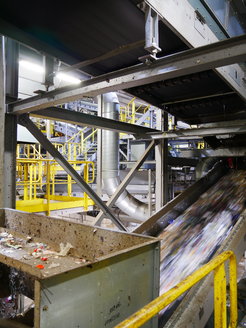The path of post-consumer waste
Recycling at a high level
A group from the MPI-P visited two recycling plants. Interested participants from various working groups and service centres came together and travelled to Gernsheim to MEILO Gesellschaft zur Rückgewinnung sortierter Werkstoffe mbH & Co. KG and then travelled to the recycler Kunststoff Recycling Grünstadt GmbH. The two tours provided a very good insight into the complexity of the various recycling processes.

MEILO in Gernsheim near Darmstadt receives the waste in yellow bags or yellow bins from a radius of 300 kilometres and sorts it using a huge range of machinery. This includes air separators, magnetic separators and near-infrared separators. MEILO is able to sort paper, various metals, foils, drinks cartons and eight different types of plastic from the post-consumer waste. Most of the separated plastics are recycled. Plastics that are too contaminated or simply cannot be separated, such as composites, are sent for thermal utilisation, i.e. being burned.
According to operations manager Manuel Götz, all the waste that is delivered still contains two thirds of trash that does not belong in the yellow bag/yellow bin. Consumers need to take a good look at themselves here. However, there are still too many composite materials in the packaging that cannot be separated in mechanical recycling and are therefore lost to recycling. These are among the 47% that are sent for energy recovery.
At this point, politicians, industry and the marketing departments of large corporations are called upon to set legal guidelines and develop packaging that reduces mixed plastics. These cannot (yet) be dispensed with everywhere in the food sector, as the so-called multilayers guarantee shelf life and protect the products: the cheese stays fresh longer and does not lose its flavour.
This is an opportunity for research to continue working on monolayers and to develop new materials or coatings that fulfil all the requirements for food.
The second visit was to Kunststoff Recycling Grünstadt. The group was given a tour of the plant, which is no smaller than the one in Gernsheim and no less impressive in terms of its machinery. However, Grünstadt mainly processes HDPE, PP, PS and technical plastics into either regrind or regranulates, which are then passed on to the plastics processing industry.
It was impressive to see how the pre-sorted plastics from the post-consumer waste are turned into small shredded flakes in many individual steps and how, after complex cleaning processes, these flakes are sent for further sorting several times. Using near-infrared scanners and optical detection, the flakes of different colours can be sorted so precisely that a homogeneous source material is obtained at the end. The melting and extrusion process is then used to produce the end product, such as white regranulate: a secondary raw material for the next beauty jar or the next bottle for the power cleanser.
The plant we visited produces high-quality regranulates from 38,000 tonnes of plastic every year. This is a coherent overall concept if the sales markets would play along to the same extent. Dr. Torben Kraffczyk, member of the management board, made it clear in the subsequent discussion after the plant tour that recyclate is not yet being purchased by all potential branches of industry in the quantities that might be possible. The group from the MPI-P learned that the more expensive recyclate is still causing customers to hesitate, especially with the current drop in the price of crude oil. At the same time, the white secondary raw material is more likely to be used for shower gel packaging than a grey one. Although the quality is the same, white packaging seems to be more suitable for the consumer and for sales figures.
After the day, it was clear to the group from the MPI-P that closed loops in both an ecological and economic sense are gradually being developed in a wide range of industries, but there is still a long way to go before these are introduced across the board and are truly sustainable and profitable for everyone involved.












